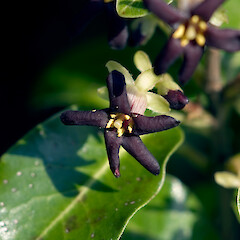Pittosporum tenuifolium
Common name
kohukohu, kōhūhū, black matipo
Synonyms
Trichilia monophylla Richard, Pittosporum fasciculatum Hook.f., Pittosporum tenuifolium subsp. fasciculatum (Hook.f.) Kirk, Pittosporum tenuifolium var. fasciculatum (Hook.f.) Kirk, Pittosporum colensoi var. fasciculatum (Hook.f.) Cheeseman, Pittosporum tenuifolium Sol. ex Gaertn. subsp. tenuifolium
Family
Pittosporaceae
Flora category
Vascular – Native
Endemic taxon
Yes
Endemic genus
No
Endemic family
No
Structural class
Trees & Shrubs - Dicotyledons
NVS code
The National Vegetation Survey (NVS) Databank is a physical archive and electronic databank containing records of over 94,000 vegetation survey plots - including data from over 19,000 permanent plots. NVS maintains a standard set of species code abbreviations that correspond to standard scientific plant names from the Ngä Tipu o Aotearoa - New Zealand Plants database.
PITTEN
Chromosome number
2n = 24
Current conservation status
The conservation status of all known New Zealand vascular plant taxa at the rank of species and below were reassessed in 2017 using the New Zealand Threat Classification System (NZTCS) – more information about this can be found on the NZTCS website. This report includes a statistical summary and brief notes on changes since 2012 and replaces all previous NZTCS lists for vascular plants.
Please note, threat classifications are often suggested by authors when publications fall between NZTCS assessment periods – an interim threat classification status has not been assessed by the NZTCS panel.
- Conservation status of New Zealand indigenous vascular plants, 2017 . 2018. Peter J. de Lange, Jeremy R. Rolfe, John W. Barkla, Shannel P. Courtney, Paul D. Champion, Leon R. Perrie, Sarah M. Beadel, Kerry A. Ford, Ilse Breitwieser, Ines Schönberger, Rowan Hindmarsh-Walls, Peter B. Heenan and Kate Ladley. Department of Conservation. Source: NZTCS and licensed by DOC for reuse under the Creative Commons Attribution 4.0 International licence.
2017 | Not Threatened
Previous conservation statuses
2012 | Not Threatened
2009 | Not Threatened
2004 | Not Threatened
Brief description
Small tree with very dark twigs bearing pale green shiny wavy thin leaves and very dark flowers and 12 mm wide capsules that split into two or three to show the black sticky seeds. Leaves usually 2–4 cm long.
Distribution
Endemic and widespread throughout country.
Habitat
A small tree of coastal to montane shrubland and forested habitats. Preferring successional habitats.
Wetland plant indicator status rating
Information derived from the revised national wetland plant list prepared to assist councils in delineating and monitoring wetlands (Clarkson et al., 2021 Manaaki Whenua – Landcare Research Contract Report LC3975 for Hawke’s Bay Regional Council). The national plant list categorises plants by the extent to which they are found in wetlands and not ‘drylands’. The indicator status ratings are OBL (obligate wetland), FACW (facultative wetland), FAC (facultative), FACU (facultative upland), and UPL (obligate upland). If you have suggestions for the Wetland Indicator Status Rating, please contact: [Enable JavaScript to view protected content]
FACU: Facultative Upland
Occasionally is a hydrophyte but usually occurs in uplands (non-wetlands).
Detailed description
Shrub or small gynodioecious tree up to 10 m tall (usually much less). Trunk 0.3–0.4(–0.6) m diam., stout, clad in dark grey-black or brown persistent bark. Branches numerous, erect then spreading. Branchlets and young leaves pubescent, hairs pale yellow or cream. Petioles short, somewhat fleshy. Leaves alternate, (10–)30(–70) x (5–)10(–20) mm, leathery, pale-green to dark green above, lighter below, oblong, oblong-ovate or elliptic-obovate, apex obtuse to acute, rarely acuminate, margins entire, often undulose. Flowers solitary or in axillary cymes, rather fragrant, especially at night. Pedicels stout, pale green, fleshy, bracts entire, lanceolate, caducous. Sepals narrowly ovate-oblong, subacute to obtuse, silky hairy. Petals 12 mm long, lanceolate, dark red, black (rarely yellow or white). Capsules 2-valved (rarely 3), subglobose, valves woody, black when mature, long persistent. Seeds immersed in sticky, red or yellow viscid pulp.
Flowering
October–November (–December)
Flower colours
Black, Red/Pink
Fruiting
January - March
Propagation technique
Easy from fresh seed. Can be grown from semi-hardwood cuttings.
Etymology
pittosporum: Pitch seed
tenuifolium: Thin leaf
Where To Buy
Very common in cultivation. Kohuhu and cultivars are commonly sold by commercial nurseries and are also grown throughout the world.
Attribution
Fact sheet prepared for NZPCN by P.J. de Lange 10 January 2004. Description adapted from Allan (1961).
References and further reading
Allan, H.H. 1961: Flora of New Zealand. Vol. I. Wellington, Government Printer
NZPCN Fact Sheet citation
Please cite as: de Lange, P.J. (Year at time of access): Pittosporum tenuifolium Fact Sheet (content continuously updated). New Zealand Plant Conservation Network. https://www.nzpcn.org.nz/flora/species/pittosporum-tenuifolium/ (Date website was queried)











